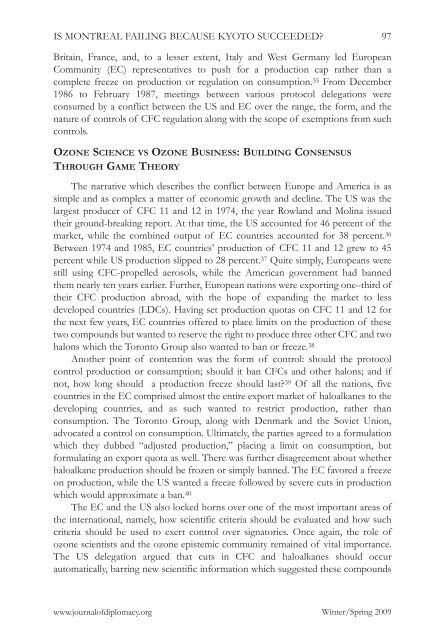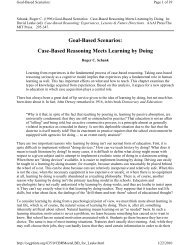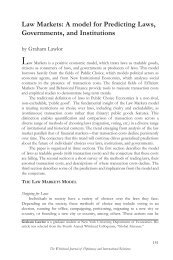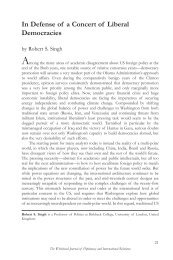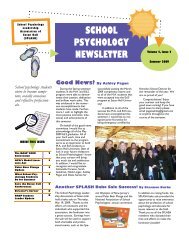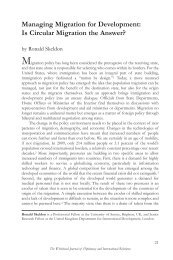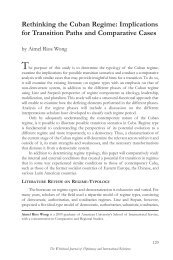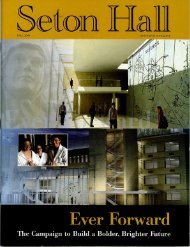Free Riders, Side Payments, and International Environmental ...
Free Riders, Side Payments, and International Environmental ...
Free Riders, Side Payments, and International Environmental ...
You also want an ePaper? Increase the reach of your titles
YUMPU automatically turns print PDFs into web optimized ePapers that Google loves.
IS MONTREAL FAILING BECAUSE KYOTO SUCCEEDED?<br />
Britain, France, <strong>and</strong>, to a lesser extent, Italy <strong>and</strong> West Germany led European<br />
Community (EC) representatives to push for a production cap rather than a<br />
complete freeze on production or regulation on consumption. 35 From December<br />
1986 to February 1987, meetings between various protocol delegations were<br />
consumed by a conflict between the US <strong>and</strong> EC over the range, the form, <strong>and</strong> the<br />
nature of controls of CFC regulation along with the scope of exemptions from such<br />
controls.<br />
OZONE SCIENCE VS OZONE BUSINESS: BUILDING CONSENSUS<br />
THROUGH GAME THEORY<br />
The narrative which describes the conflict between Europe <strong>and</strong> America is as<br />
simple <strong>and</strong> as complex a matter of economic growth <strong>and</strong> decline. The US was the<br />
largest producer of CFC 11 <strong>and</strong> 12 in 1974, the year Rowl<strong>and</strong> <strong>and</strong> Molina issued<br />
their ground-breaking report. At that time, the US accounted for 46 percent of the<br />
market, while the combined output of EC countries accounted for 38 percent. 36<br />
Between 1974 <strong>and</strong> 1985, EC countries’ production of CFC 11 <strong>and</strong> 12 grew to 45<br />
percent while US production slipped to 28 percent. 37 Quite simply, Europeans were<br />
still using CFC-propelled aerosols, while the American government had banned<br />
them nearly ten years earlier. Further, European nations were exporting one–third of<br />
their CFC production abroad, with the hope of exp<strong>and</strong>ing the market to less<br />
developed countries (LDCs). Having set production quotas on CFC 11 <strong>and</strong> 12 for<br />
the next few years, EC countries offered to place limits on the production of these<br />
two compounds but wanted to reserve the right to produce three other CFC <strong>and</strong> two<br />
halons which the Toronto Group also wanted to ban or freeze. 38<br />
Another point of contention was the form of control: should the protocol<br />
control production or consumption; should it ban CFCs <strong>and</strong> other halons; <strong>and</strong> if<br />
not, how long should a production freeze should last? 39 Of all the nations, five<br />
countries in the EC comprised almost the entire export market of haloalkanes to the<br />
developing countries, <strong>and</strong> as such wanted to restrict production, rather than<br />
consumption. The Toronto Group, along with Denmark <strong>and</strong> the Soviet Union,<br />
advocated a control on consumption. Ultimately, the parties agreed to a formulation<br />
which they dubbed “adjusted production,” placing a limit on consumption, but<br />
formulating an export quota as well. There was further disagreement about whether<br />
haloalkane production should be frozen or simply banned. The EC favored a freeze<br />
on production, while the US wanted a freeze followed by severe cuts in production<br />
which would approximate a ban. 40<br />
The EC <strong>and</strong> the US also locked horns over one of the most important areas of<br />
the international, namely, how scientific criteria should be evaluated <strong>and</strong> how such<br />
criteria should be used to exert control over signatories. Once again, the role of<br />
ozone scientists <strong>and</strong> the ozone epistemic community remained of vital importance.<br />
The US delegation argued that cuts in CFC <strong>and</strong> haloalkanes should occur<br />
automatically, barring new scientific information which suggested these compounds<br />
www.journalofdiplomacy.org<br />
97<br />
Winter/Spring 2009


